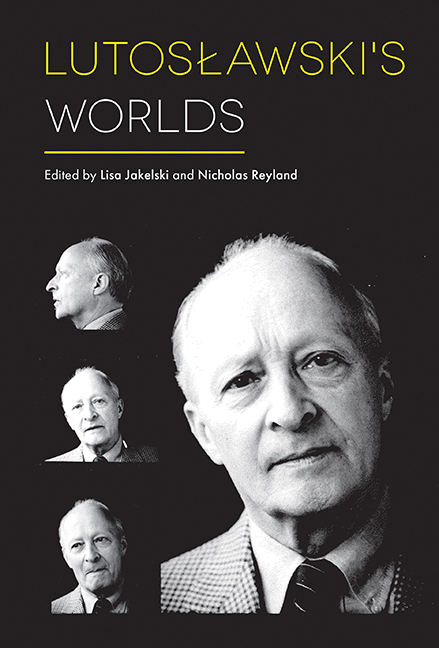Book contents
- Frontmatter
- Dedication
- Contents
- List of Figures
- List of Tables
- List of Music Examples
- List of Contributors
- Acknowledgements
- Introduction
- PART I mourning, modernism, and genius
- 1 Witold Lutoslawski's Muzyka zalobna (1958) and the Construction of Genius
- 2 Personal Loss, Cultural Grief, and Lutoslawski's Music of Mourning
- 3 Lutoslawski's String Quartet: Mourning, Melancholia, and Modern Subjectivity
- PART II other lutoslawskis
- PART III documents
- PART IV political engagement
- PART V legacies
- Bibliography
- Index
2 - Personal Loss, Cultural Grief, and Lutoslawski's Music of Mourning
from PART I - mourning, modernism, and genius
Published online by Cambridge University Press: 14 June 2019
- Frontmatter
- Dedication
- Contents
- List of Figures
- List of Tables
- List of Music Examples
- List of Contributors
- Acknowledgements
- Introduction
- PART I mourning, modernism, and genius
- 1 Witold Lutoslawski's Muzyka zalobna (1958) and the Construction of Genius
- 2 Personal Loss, Cultural Grief, and Lutoslawski's Music of Mourning
- 3 Lutoslawski's String Quartet: Mourning, Melancholia, and Modern Subjectivity
- PART II other lutoslawskis
- PART III documents
- PART IV political engagement
- PART V legacies
- Bibliography
- Index
Summary
The cultural repression of Poland began slowly to thaw after Stalin's death in 1953. Within a year, for instance, Witold Lutosławski was contemplating a commission offering him the chance – his first since the onset of World War II – to compose and then to hear publicly performed experimental music. His response to this opportunity was a work that could scarcely have been further removed from the socialist realist mandate for upbeat folklorism fulfilled by his then most recent major pieces, the neo-classical and tonal Concerto for Orchestra (1950–54) and Dance Preludes (1954). Earlier scholarship on this departure has tended to sideline its idiosyncratic utilization of dodecaphony as a transitional road-not-taken in Lutosławski's development of a modernist voice, albeit while noting the piece to be a particularly wellrealized example of the initial phase of Polish engagement with the postwar musical avant-garde. More recently, Lisa Cooper Vest has identified its function (see previous chapter) as an expedient calling card, at home and abroad, for a musician feted as Poland's next leading composer, thanks in part to its combination of cautious innovation and expressive tendencies looking back to the recent musical past – the core elements of what Steven Stucky identified as the piece's ‘undogmatic and humanistic modernism’.
In another sense, however, the new piece would prove to be foundational Lutosławski. A quadrilateral equation of grief in which signifiers of lament, anger and violence calculate the unknown quantity – suffering – the music set a template for many Lutosławski pieces yet to come. The title of the work, in turn, indicates ways in which Lutosławski's first post-Stalinist composition could be conceived as an experiment in more than just a new compositional language. Its chief symbolic topic, mourning, was an experience with which Lutosławski had become horribly well acquainted by 1954. The music may also mark, as such, a turning point after which Lutosławski's works achieve a more strongly personal quality, the interpretation of which demands judicious analysis of both music and context – a complicated and controversial task for Lutosławski scholarship, as discussed shortly below. First, however: what should this defining piece be called?
In 1954, conductor and Lutosławski supporter Jan Krenz suggested to the composer that he write some music to commemorate the tenth anniversary of Bartók's death on 26 September 1955.
- Type
- Chapter
- Information
- Lutoslawski's Worlds , pp. 39 - 70Publisher: Boydell & BrewerPrint publication year: 2018



